There are a few different things you could do on the 21st of June. One could join the celebration of the World Humanist Day, although I have no idea what people do there. You could participate in one of the numerous events hosted by local skate shops in honour of Go Skateboarding Day, the only “official” holiday embedded into the world of skateboarding. Maybe you’re present at the opening of the brand new skatepark in Groningen, or you’re watching the Dutch National Road Race Championships in Elspeet. Maybe you’re laying on a beach somewhere, using the longest day in the year to finally get that summer tan ready.
Or, there’s a chance you went to Westblaak for a skateboard contest, hosted by our colleagues from Flatspot Magazine and their German friends.
Written by Sander Rodenhuis, photography by Frederick Walker.
What did I do? Well, I went to Westblaak, although I arrived there a small eight hours before the contest people arrived. Meeting up at a skatepark at 10 in the morning is not my favourite thing to do, but I had a very good excuse: the start of the Skate Symposium, hosted by AIR - Architectuur Instituut Rotterdam, as part of the Rotterdam Architectuur Maand.
I wasn’t the only skater showing up: Kim Butter cycled into the park a few moments earlier, and my arrival was quickly followed by the entrée of Mike van Staten. Despite knowing Kim for seven or eight years now, it’s hard to come up with a proper way to introduce her. Right now, I’m landing on: local skater, world-improver, activist, community organiser and spokesperson for the Rotterdam skate scene. Mike is a local skater, urban designer and most importantly for today: the best spot guide anyone could wish for.
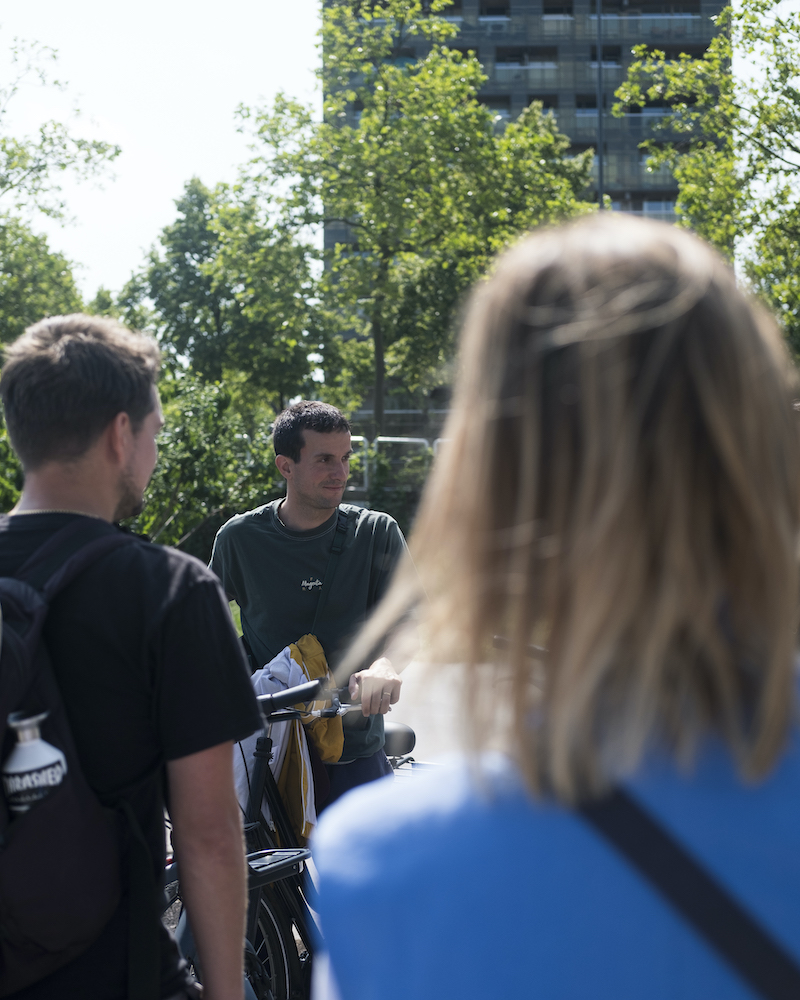
Special guest for the day was Leo Valls, professional skater for Magenta Skateboards and spokesperson for the Skaturbanism movement. Leo has been one of the key figures in Bordeaux, transforming the city from a conservative and skateboard-unfriendly city into one of the best examples of council and skaters working together to make public space a welcoming environment again.
The rest of the group consisted of policy makers, landscape architects and urban planners from the municipality, a local politician, architects and part of the team of AIR.
Spot tour
Our activities for the day started with a spot tour led by Mike, focusing mostly on spots that are not skateable anymore. Obviously, Westblaak functions as the meetup spot for many, but where does one go when it’s wet/raining in Rotterdam? It used to be the Maritiem Museum, until the Museum placed skate stoppers and a sculpture on the spot, making it unskateable. Looking at the stoppers placed on a perfectly grindable “ledge”, the question of who placed the stoppers arose: was it the Museum, or was it the city? Where does the city end and private property start?
Already, at this first example of skate stoppers, the minds of the municipality people were blown: they had never thoroughly thought about these things before! Within 20 minutes of meeting, cycling and talking it became clear that this would be a day full of moments like this for anyone that never talked to a skater before.
Around the corner from Maritiem is Plein 1940, a spot that has been in use by skaters for a long time, with lots of footage from this spot in multiple videos, including the Bombaklats series. The square itself is not really special: there’s a bench, lots of flatground, a stair set with multiple options for height and distance, and there are a few “putjes” to prop up to use as a launch ramp. Mike explained that due to Maritiem being scrapped from the spot list, Plein 1940 has been seeing more use, which was exemplified by a ‘putje’ that was propped up. Mike gave a little putjes demo to show that a lot of times, the simple stuff is the best to skate: all you need is a big square with a few things here and there, and you’re good to go. The city is a playground, and simple interventions like this create a skateable city. Minds were blown and new insights created, once again.
Next up during the tour was the Weena spot, where skate stoppers were placed on the floor, not only making the space unsuited for skaters but also for people with trolleys, strollers generally making walking underneath the building dangerous due to an increased chance of tripping and falling.
- Blaak
- Maritiem Museum
- Weena - Skatestoppers
- GLR (Benthemplein)
- Letters-spot
- Oude Haven
- Boompjeskade
- Wokkel (Erasmusbrug)
- Kop van Zuid
Letters
One of the most important spots that Mike led us to is the place known by Rotterdam locals as Letters. Actually, I think knowledge of this spot has reached places far beyond Rotterdam, mostly thanks to JM Sneep’s selfie skate clips. I’m not exactly sure how this place started, but I do know that at some point Opperclaes, a local design studio, had some leftover obstacles from previous events and decided to place them at the asphalt circle of the Park Pompenburg. More and more letter-shaped obstacles followed, and as Mike told us, the municipality shut one eye, allowing the space to exist for a fairly long time. Multiple events were held at the spot, which functioned more and more as a meetup spot and alternative for Westblaak, which can sometimes be too crowded to be properly enjoyed.
Due to the obstacles becoming more and more unsafe, the city removed the letters, leaving only two slappy curbs and one newly placed quarter ramp. (Instagram stories of local skaters are showing the addition of a ledge, too)
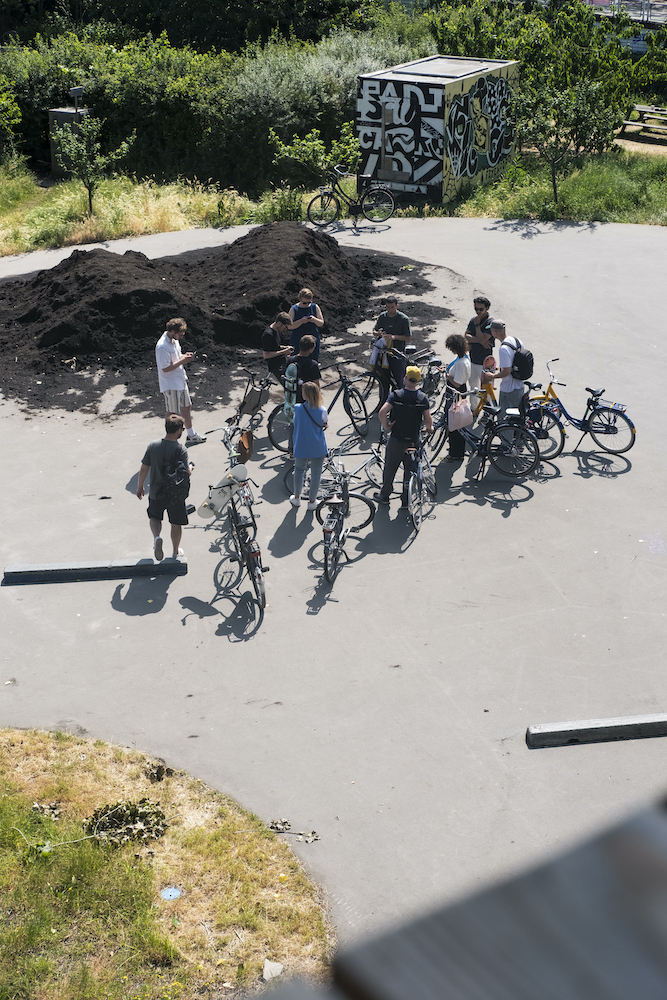
Talking about safety, Mike and Leo exemplified how places like this can function as a way to make the whole neighbourhood safer: it has been shown in actual academic research that the presence of groups of skaters lead to a higher feeling of safety in a certain area.
One thing Leo noted as well is the difference between objects for sport and objects as art. Placing a skateable object that is classified as an artwork is easier than placing an obstacle that is classified as a sport instrument, due to the rules and regulations for play and sports objects. They need to be safe and sound so no harm can fall to the user of the object. However, Leo has found a way around these regulations in Bordeaux by claiming the skateable objects as art objects so less regulation is needed.
It’s not all so bad
Not all spots we visited were faulty ones: at the end of the tour we looked at the Hotel New York spot, after spending a few minutes at the Erasmusbrug wave and bank. All of them are spots where skating is perfectly possible. Of course, there are skate stoppers installed on the Erasmus bank, but one can argue that the stoppers made this bank better than before. After performing a trick from the top, into the bank, one must clear the skate stoppers at the bottom of the bank. This combination of spot and stoppers make every clip filmed here a good watch.
One thing Leo noticed at Hotel New York was damage done by skateboarders: a wooden plank at the landing zone behind a ledge had snapped, making the spot unsafe for both skaters and pedestrians. Leo mentioned that once every year in Bordeaux, he sets up a day of spot fixing, inviting locals to come on a tour to make repairs to spots damaged by skating. He explained that it’s important to not only take from the city, but also give back as well. Not only do the skaters work out what their place is in a city, but it also helps give a positive vibe to skateboarding. If you want to change the way society looks at skateboarding, it doesn’t help if you’re only going to do what you’ve always done.
As the spot tour ended we were left with the feeling of having seen a city where the options to skate are there, but the mindset of the people around those options is not there yet. Rotterdam is known for its modern architecture and recently built infrastructure. Changing the mindset around how we as skaters use Rotterdam’s buildings, squares, benches and fountains will undeniably help to put Rotterdam back on the list of skateboard destinations around Europe and possibly the world. The more we can skate around the city without having to search for suitable skate spots, that have not been stopped yet, or places where it’s clear you get a fine, the easier it is to document and share what we’ve done. And the more that documentation of skate spots and tricks is seen by other skaters, the more skaters will come to Rotterdam.
Basically, attracting more skate tourists doesn’t require the city to build a skatepark worth one million euros, it’s only needed to change the mindset about skateboarding into a positive one.
The start of that positivity was visible during the tour and even more during the rest of the program.
Lunch
Not long after Hotel New York we headed to the festival heart of the Rotterdam Architecture Month, to catch a breath, eat lunch and prepare for the next leg of the day.
We gathered at one of the three barges to listen to a few talks/presentations. Eva van Breugel, head of programme at AIR, starts with an introduction to the Skate Symposium, introducing Kim Butter to the crowd and telling the story of the Museumpark debacle. She also gave a little summary of the tour we did in the morning and the things we learned by listening to Mike, Leo and Kim and talking to all the different people present at the tour.
Leo’s talk
After Eva, Leo took the stage and gave his talk about skate urbanism. Leo is responsible for multiple successful projects incorporating skateboarding into different aspects of “city life” in his hometown of Bordeaux. During the last few years he has given multiple talks around Europe about skate urbanism, and helped spark projects in Malmö, Berlin and other cities.
While the architecture in Rotterdam differs a lot from Bordeaux, mostly in the lack of marble everywhere, Leo’s message and knowledge can be applied anywhere four hard wheels and a board touch the ground.
His talk in Rotterdam started with an introduction of who he is, how he started skateboarding and what skateboarding means to him. As a skateboarder myself, it’s easy to forget to include points like these whenever we talk to non-skaters about skateboarding. Hearing Leo talk about our passion in a sort of ‘Jip-en-Janneke-taal’ was a good reminder for myself, but mostly a good way to give the non-skating crowd a good base for the rest of the afternoon. The crowd consisted of municipality workers ranging from city management, (urban) sports department to city development, architects, designers, some journalists and politicians.
Skateboarding is a way to redefine what is around you, asking questions to yourself and others about what’s around you, about space, individuality, creativity. Leo also mentioned that skateboarding can be anything you want it to be: an olympic sport, a tool to buy bread in the morning, or a social tool to empower different walks of life. Basically, skateboarding is chameleon and can take any shape or colour you want it to.
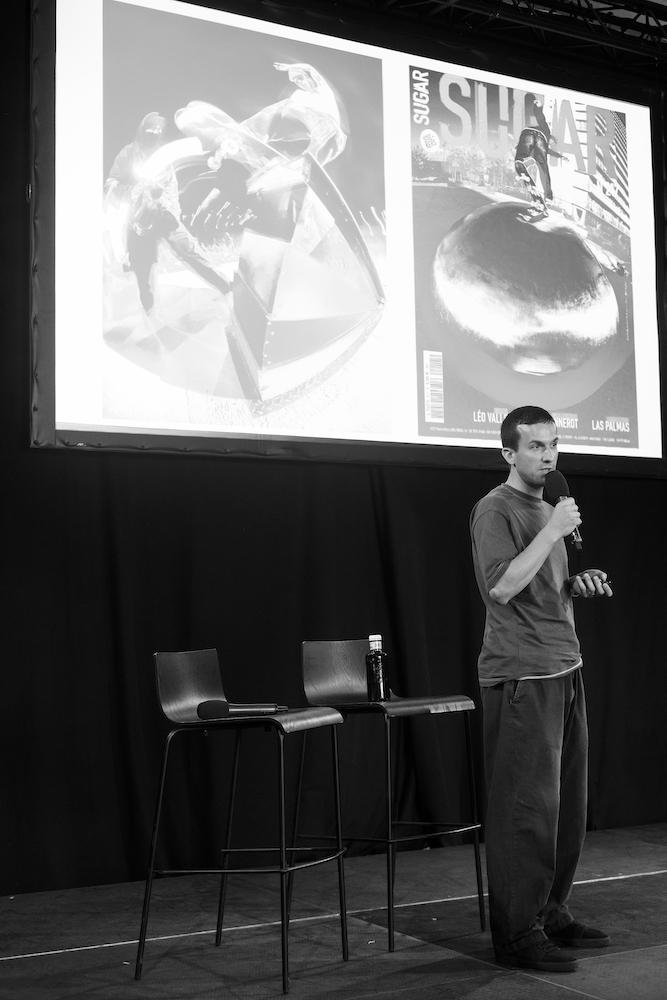
The infinity of skating
The infinity of skating. Four words that Leo liked to repeat throughout his talk. They circle back to his point about the chameleon: skateboarding can be whatever you want it to be. But it’s not just you that has a voice in what it is, your surroundings dictate your style of skateboarding too. Different cities inspire different styles of skateboarding. Skateboarders from New York do different things than skateboarders from LA. And although the distances in our little country are small, it’s not hard to differentiate between a skater from Amsterdam or a skater from Rotterdam. Because skaters are keen to start projects and create photo publications and videos, local skaters are motivated to start their own things, and outsiders are excited to visit the city and see how they can relate to what they’ve seen in the videos. This is how skate-tourism starts: a local style emerges that gets spread around through different forms of media, and skaters from outside will come soon enough.
Now, I could go on and on about the things Leo talked about and the way I feel about them. However, skateboarding is infinite and I think I would end up with a very long text, because I love this infinity.
Street vs park
An important aspect Leo talked about was the idea that skateparks do not (and can not) replace street spots. Cities believe that when they build a skatepark, usually not the cheapest thing to do, all street skateboarders will go to the park and all problems of skateboarding interfering with your city go away. What does happen is that when you build a park and kids start skating in it, they will undoubtedly end up getting more and more into the act of skateboarding, eventually opening a magazine or seeing videos where everything is based around street skateboarding. They want to experience the unique feeling of street skateboarding and being in the midst of a city too. This is why Leo believes that cities should not only build skateparks, but also validate street spots where possible, by working with local skaters.
Working with local skaters does not mean working with all of the skaters. A few of them is enough to keep the lines direct and organised. In Bordeaux, Leo and his workgroup came up with a skate masterplan: a plan in which you zoom out, seeing the city as a wall. Leo met all different departments of the city council during six months, and talked with them about incorporating skateboarding into their urban development plans. He stressed that sometimes it’s okay if it doesn’t work out, you’re not going to build a spot in front of a retirement home. It was also important to pin all the spots on a map, to figure out how local skaters would use the spots, in what order, and what routes in between would be taken.
After this, a project with the cultural department was started, organising a spot route using different skateable artworks. One of them was a bench that was placed on a ledge, in which the ledge could be used for skateboarding, and the bench for sitting. It showed that there are possibilities of sharing spaces instead of keeping things divided. It takes time, a lot of work and even more talking. But once the conversation is underway, it’s easy to keep it going.

Somebody help Kim
But, and this is the big culprit for Rotterdam right now: you need a spokesperson or mediator. Right now, it feels like Kim is taking this job, being one of the organisers of the symposium. The problem here is that Kim took this responsibility voluntarily and as an effect of the Museumpark closing down. It’s not a thing you can do in your spare time, chasing down council workers, asking questions about new development plans, figuring out what fits where, who to talk to, what department is in charge, I probably don’t even know half of the work necessary.
The other way around, you have the problem of the city not being able or capable of finding the right skaters to talk to, resulting in a stalemate. Things continue to be brought to light by skaters, plans will be made by the city, but there is no ongoing and durable conversation.
So, before even thinking about possibilities about spots, materials, locations, I think the #1 thing to do in Rotterdam is find a suitable spokesperson, and to make sure the city pays this person. I am not going to yell names, because after all, I am only a skate tourist looking in on the Rotterdam skate scene.
Workshops
The third and last leg of the day consisted of various workshops. The one I attended was a talk with Leo and Kim about skateboarding as a social tool. Gathering for the workshop I had the fear that there were only skaters at the table, luckily, people from the municipality joined, making the conversation much more interesting.
Important things to take away from this conversation were the realisation of the infinity of skating, as there are so many aspects in life skateboarding can be applied to. Whether it’s architecture, design, mental health, social issues, you name it. Skateboarding functions as a gateway into these different aspects, and there are many examples of people using that skateway (sorry) to become experts of the direction they chose. Some become urban designers like Mike, others focus on the artistic side and still others use skateboarding as a social tool, like Kim did with Women Skate the World and New Wave.
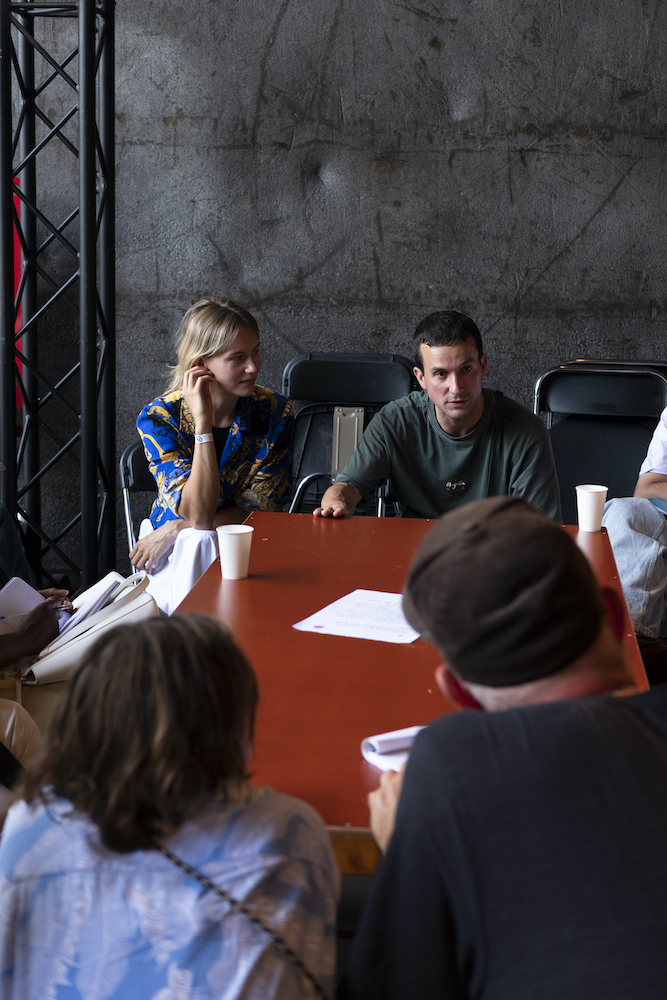
Another important note was the idea of taking the shape of your environment. Don’t just build a random and expensive park somewhere: look at what's already there, base your ideas around that.
Skate tourism also came to the table, which was also the point where the skate media (myself) entered the chat. After all, the more we as media show certain cities and spots, the more people will visit these spots and thus contribute to the general tourism economy of a city. Expensive skateparks are not the reason street skateboarders come to a city, it’s the way spots look on photo and video, and the stories they hear about certain places. Is the spot they’re travelling to Rotterdam for a guaranteed kick-out, or is it a welcoming spot with perhaps even a bar or cafe to drink a beer at? All of this helps with the positive mindset around skateboarding. I’m not saying that every skate spot should have a cafe next to it, I’m saying that if skaters are welcome to skate spots next to local businesses, chances are high those same skaters will support these local businesses. Nothing beats a fresh coffee or a cold beer on the session.
Other workshops were led by design studio Opperclaes (Designing Skateable Objects), Atelier OUI (Conditions in Process & Design), architect Victor Verhagen & Christophe Cornille of the Rotterdam municipality (Masterplan Skateboarding in Rotterdam) and Mike (Tour: The City Through the Eyes of a Skateboarder).
Pulling from notes sent to me, Bruce Tsai, Opperclaes leader, mostly focused on the limitations set by certain rules about skateable objects. Who is responsible if something happens on the object you placed into public space? It seems like multiple cities deal differently with this question.
Atelier OUI used a model of the Nelson Mandelapark as base for their workshop. The park will be built on the same location the festival was held, and after a participation project with local residents from surrounding areas it became clear that there was a need for the incorporation of urban sports into the park. Although most of the park has been designed, there are still details to be filled in. Thus, the workshop became quite specific and practical: what kind of material was needed, how high should a ledge be? At the same time, the question of the amount of usage arose. How do you attract skaters, and make sure they use what you designed for them? Skateboarding is based on spontaneous acts, so it could be tricky or scary to design a bench for skaters. On the other hand, I’d argue that a bench still functions as a bench, regardless if it’s skated or not.
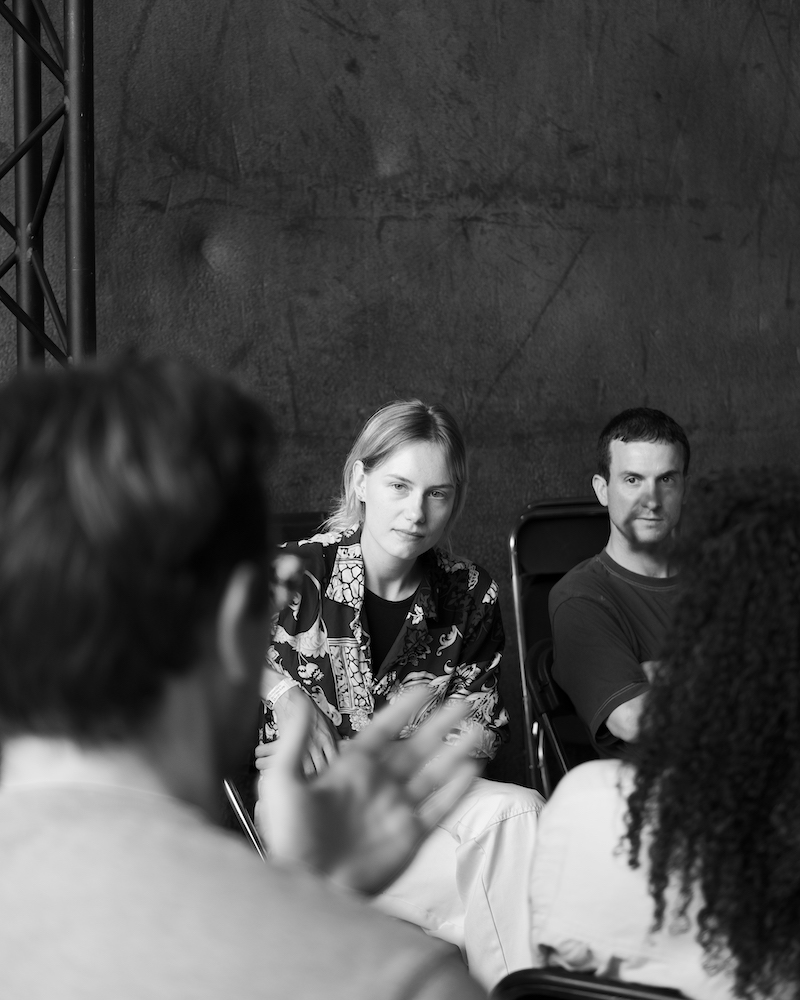
Benches and spokespersons
Talking about benches, Victor Verhagen mentions in his workshop notes an idea about having a skateable bench in the city catalogue. This way, the city doesn’t need any knowledge about skate spots, but there is still a guarantee for new spots whenever a bench is placed somewhere. Victor concluded that there’s a discussion between experimental objects that fit within skateboardings everlasting quest of discovering the city, and the need for management and regulating of these spots.
This was also felt by Mike van Staten during his tour in the afternoon. As a worker of the city management, present during the tour, noted: if you place a tree trunk somewhere with the label of play object, you get in trouble. There’s rules for safety, rubber tiles must be added around the tree. But if you place it in a grass field, it’s not a play object anymore, it’s considered as a bench. Mike also says that it’s important to never consider a design finished, the design only starts once the object starts to be used. The bench can evolve, even after placing it in a street, on a square, or in front of the station.
One thing I found in every workshop notes file: there is a need for a spokesperson or mediator between skaters and city, to simplify the process and get better results. This is also something Leo emphasised in his talk and the thing that I feel is the most important right now, as I said earlier. Find a suitable person, maybe two or three, and make sure that what they do is appreciated from both sides of the table.
Start the conversation, meet all departments within the city, and see what you want from each other.
On the way back
The day ended with a summary of all the workshops and a little after drink. I couldn’t stay for the skate session on the mini ramp as I had to hop on a train back to Groningen. It took me 4,5 hours to get back to Groningen, where, instead of going home, I joined the end of a session at the newly built skatepark, the first proper skatepark the city of Groningen had ever seen. This made me the first person ever to skate both Westblaak and de Paardenbak on the same day, making me realise that whatever city a Skate Symposium will be held in, skateboarding is universal and everything it teaches you, can be applied anywhere. Of course, you can’t just copy and paste Rotterdam’s case into Groningen, and vice versa. Every city has their own environment, and if there’s anything you can learn from skating, it’s the ability to adapt to whatever environment you find yourself in.



